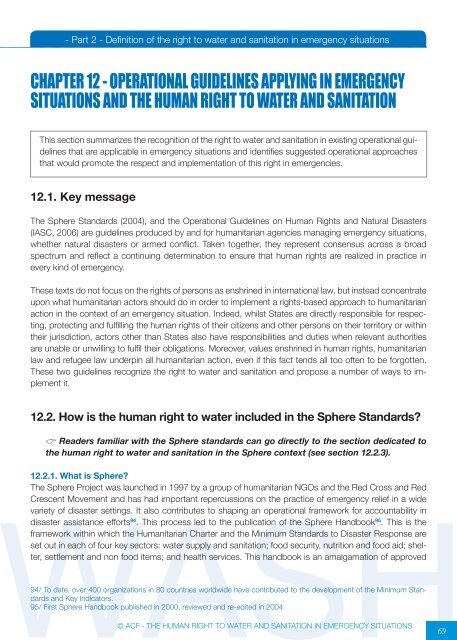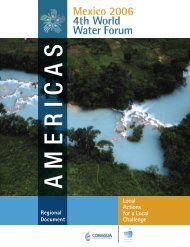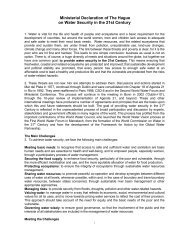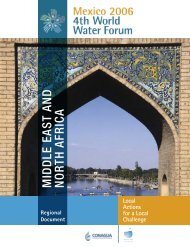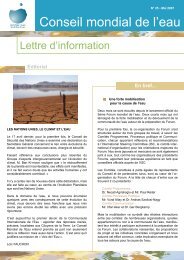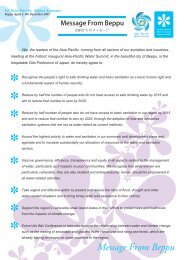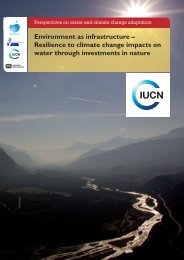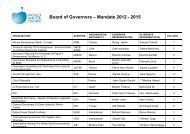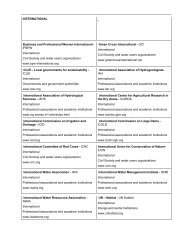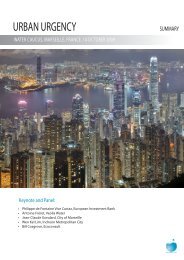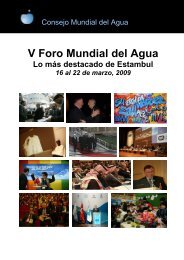the human right to water and sanitation in emergency situations
the human right to water and sanitation in emergency situations
the human right to water and sanitation in emergency situations
You also want an ePaper? Increase the reach of your titles
YUMPU automatically turns print PDFs into web optimized ePapers that Google loves.
- Part 2 - Def<strong>in</strong>ition of <strong>the</strong> <strong>right</strong> <strong>to</strong> <strong>water</strong> <strong>and</strong> <strong>sanitation</strong> <strong>in</strong> <strong>emergency</strong> <strong>situations</strong><br />
CHApTER 12 - OpERATIONAl GUIDElINES ApplYING IN EMERGENCY<br />
SITUATIONS AND THE HUMAN RIGHT TO WATER AND SANITATION<br />
This section summarizes <strong>the</strong> recognition of <strong>the</strong> <strong>right</strong> <strong>to</strong> <strong>water</strong> <strong>and</strong> <strong>sanitation</strong> <strong>in</strong> exist<strong>in</strong>g operational guidel<strong>in</strong>es<br />
that are applicable <strong>in</strong> <strong>emergency</strong> <strong>situations</strong> <strong>and</strong> identifies suggested operational approaches<br />
that would promote <strong>the</strong> respect <strong>and</strong> implementation of this <strong>right</strong> <strong>in</strong> emergencies.<br />
12.1. Key message<br />
The Sphere St<strong>and</strong>ards (2004), <strong>and</strong> <strong>the</strong> Operational Guidel<strong>in</strong>es on Human Rights <strong>and</strong> Natural Disasters<br />
(IASC, 2006) are guidel<strong>in</strong>es produced by <strong>and</strong> for <strong>human</strong>itarian agencies manag<strong>in</strong>g <strong>emergency</strong> <strong>situations</strong>,<br />
whe<strong>the</strong>r natural disasters or armed conflict. Taken <strong>to</strong>ge<strong>the</strong>r, <strong>the</strong>y represent consensus across a broad<br />
spectrum <strong>and</strong> reflect a cont<strong>in</strong>u<strong>in</strong>g determ<strong>in</strong>ation <strong>to</strong> ensure that <strong>human</strong> <strong>right</strong>s are realized <strong>in</strong> practice <strong>in</strong><br />
every k<strong>in</strong>d of <strong>emergency</strong>.<br />
These texts do not focus on <strong>the</strong> <strong>right</strong>s of persons as enshr<strong>in</strong>ed <strong>in</strong> <strong>in</strong>ternational law, but <strong>in</strong>stead concentrate<br />
upon what <strong>human</strong>itarian ac<strong>to</strong>rs should do <strong>in</strong> order <strong>to</strong> implement a <strong>right</strong>s-based approach <strong>to</strong> <strong>human</strong>itarian<br />
action <strong>in</strong> <strong>the</strong> context of an <strong>emergency</strong> situation. Indeed, whilst States are directly responsible for respect<strong>in</strong>g,<br />
protect<strong>in</strong>g <strong>and</strong> fulfill<strong>in</strong>g <strong>the</strong> <strong>human</strong> <strong>right</strong>s of <strong>the</strong>ir citizens <strong>and</strong> o<strong>the</strong>r persons on <strong>the</strong>ir terri<strong>to</strong>ry or with<strong>in</strong><br />
<strong>the</strong>ir jurisdiction, ac<strong>to</strong>rs o<strong>the</strong>r than States also have responsibilities <strong>and</strong> duties when relevant authorities<br />
are unable or unwill<strong>in</strong>g <strong>to</strong> fulfil <strong>the</strong>ir obligations. Moreover, values enshr<strong>in</strong>ed <strong>in</strong> <strong>human</strong> <strong>right</strong>s, <strong>human</strong>itarian<br />
law <strong>and</strong> refugee law underp<strong>in</strong> all <strong>human</strong>itarian action, even if this fact tends all <strong>to</strong>o often <strong>to</strong> be forgotten.<br />
These two guidel<strong>in</strong>es recognize <strong>the</strong> <strong>right</strong> <strong>to</strong> <strong>water</strong> <strong>and</strong> <strong>sanitation</strong> <strong>and</strong> propose a number of ways <strong>to</strong> implement<br />
it.<br />
12.2. How is <strong>the</strong> <strong>human</strong> <strong>right</strong> <strong>to</strong> <strong>water</strong> <strong>in</strong>cluded <strong>in</strong> <strong>the</strong> Sphere St<strong>and</strong>ards?<br />
c Readers familiar with <strong>the</strong> Sphere st<strong>and</strong>ards can go directly <strong>to</strong> <strong>the</strong> section dedicated <strong>to</strong><br />
<strong>the</strong> <strong>human</strong> <strong>right</strong> <strong>to</strong> <strong>water</strong> <strong>and</strong> <strong>sanitation</strong> <strong>in</strong> <strong>the</strong> Sphere context (see section 12.2.3).<br />
12.2.1. What is Sphere?<br />
The Sphere Project was launched <strong>in</strong> 1997 by a group of <strong>human</strong>itarian NGOs <strong>and</strong> <strong>the</strong> Red Cross <strong>and</strong> Red<br />
Crescent Movement <strong>and</strong> has had important repercussions on <strong>the</strong> practice of <strong>emergency</strong> relief <strong>in</strong> a wide<br />
variety of disaster sett<strong>in</strong>gs. It also contributes <strong>to</strong> shap<strong>in</strong>g an operational framework for accountability <strong>in</strong><br />
disaster assistance efforts 94 . This process led <strong>to</strong> <strong>the</strong> publication of <strong>the</strong> Sphere H<strong>and</strong>book 95 . This is <strong>the</strong><br />
framework with<strong>in</strong> which <strong>the</strong> Humanitarian Charter <strong>and</strong> <strong>the</strong> M<strong>in</strong>imum St<strong>and</strong>ards <strong>to</strong> Disaster Response are<br />
set out <strong>in</strong> each of four key sec<strong>to</strong>rs: <strong>water</strong> supply <strong>and</strong> <strong>sanitation</strong>; food security, nutrition <strong>and</strong> food aid; shelter,<br />
settlement <strong>and</strong> non food items; <strong>and</strong> health services. This h<strong>and</strong>book is an amalgamation of approved<br />
94/ To date, over 400 organizations <strong>in</strong> 80 countries worldwide have contributed <strong>to</strong> <strong>the</strong> development of <strong>the</strong> M<strong>in</strong>imum St<strong>and</strong>ards<br />
<strong>and</strong> Key Indica<strong>to</strong>rs.<br />
95/ First Sphere H<strong>and</strong>book published <strong>in</strong> 2000, reviewed <strong>and</strong> re-edited <strong>in</strong> 2004.<br />
© ACF - THE HUMAN RIGHT TO WATER AND SANITATION IN EMERGENCY SITUATIONS<br />
69


